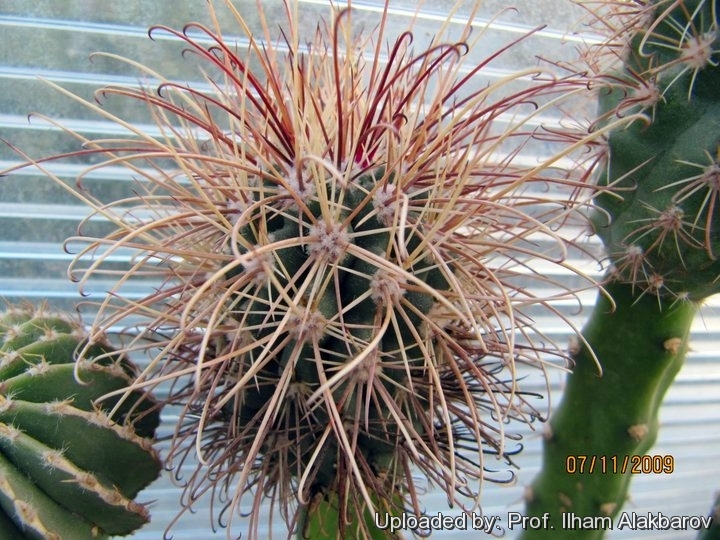Donate now to support the LLIFLE projects.
Your support is critical to our success.
Your support is critical to our success.
Pediocactus parviflorus subs. havasupaiensis
Acta Mus. Richnov., Sect. Nat. 5(1): 15 (1998)
Family: CACTACEAE
Acta Mus. Richnov., Sect. Nat. 5(1): 15 (1998)
Family: CACTACEAE
Accepted Scientific Name: Sclerocactus parviflorus subs. havasupaiensis (Clover) Hochstätter
Succulenta (Netherlands) 74: 38. 1995

Pediocactus parviflorus subs. havasupaiensis (Sclerocactus parviflorus subs. havasupaiensis) Photo by: Prof. Ilham Alakbarov
Synonyms:
- Sclerocactus parviflorus subs. havasupaiensis (Clover) Hochstätter
- Echinocactus parviflorus var. havasupaiensis (Clover) L.D.Benson
- Pediocactus parviflorus subs. havasupaiensis (Clover) Halda
- Sclerocactus havasupaiensis Clover
See all synonyms of Sclerocactus parviflorus
back
Accepted name in llifle Database:Sclerocactus parviflorus Clover & Jotter
Bull. Torrey Bot. Club 68: 419, fig. 1941
Synonymy: 6
- Sclerocactus parviflorus Clover & Jotter
- Echinocactus parviflorus (Clover & Jotter) L.D.Benson
- Ferocactus parviflorus (Clover & Jotter) N.P.Taylor
- Pediocactus parviflorus (Clover & Jotter) Halda
- Sclerocactus contortus K.D.Heil
- Sclerocactus parviflorus var. blessingiae W.H.Earle
Sclerocactus parviflorus subs. havasupaiensis (Clover) Hochstätter
Succulenta (Netherlands) 74: 38. 1995
Synonymy: 7
- Sclerocactus parviflorus subs. havasupaiensis (Clover) Hochstätter
- Echinocactus parviflorus var. havasupaiensis (Clover) L.D.Benson
- Pediocactus parviflorus subs. havasupaiensis (Clover) Halda
- Sclerocactus havasupaiensis Clover
- Sclerocactus havasupaiensis var. roseus Clover
- Echinocactus parviflorus var. roseus (Clover) L.D.Benson
- Sclerocactus whipplei var. roseus (Clover) L.D.Benson
Sclerocactus parviflorus subs. intermedius (Peebles) K.D.Heil & J.M.Porter
Haseltonia 2: 27. 1994
Synonymy: 6
- Sclerocactus parviflorus subs. intermedius (Peebles) K.D.Heil & J.M.Porter
- Pediocactus parviflorus subs. intermedius (Peebles) Halda
- Sclerocactus intermedius Peebles
- Sclerocactus parviflorus var. intermedius (Peebles) D.Woodruff & L.D.Benson
- Sclerocactus whipplei var. intermedius (Peebles) L.D.Benson
- Sclerocactus whipplei var. reevesii Castetter, P.Pierce & K.H.Schwer.
Sclerocactus parviflorus subs. macrospermus (Hochstätter) Hochstätter
Gen. Sclerocactus 27. 2005 nom. inval. without exact basionym page; see Art. 33.3 note 1 ICBN (2000)
Synonymy: 2
- Sclerocactus parviflorus subs. macrospermus (Hochstätter) Hochstätter
- Sclerocactus parviflorus f. macrospermus Hochstätter
Sclerocactus parviflorus subs. terrae-canyonae (K.D.Heil) K.D.Heil & J.M.Porter
Haseltonia 2: 27. 1994
Synonymy: 3
- Sclerocactus parviflorus subs. terrae-canyonae (K.D.Heil) K.D.Heil & J.M.Porter
- Sclerocactus parviflorus f. terrae-canyonae (K.D.Heil) Hochstätter
- Sclerocactus terrae-canyonae K.D.Heil
Sclerocactus parviflorus subs. variiflorus (Hochstätter) Hochstätter
Gen. Sclerocactus 29. 2005 nom. inval. without exact basionym page; see Art. 33.3 note 1 ICBN (2000)
Synonymy: 2
- Sclerocactus parviflorus subs. variiflorus (Hochstätter) Hochstätter
- Sclerocactus parviflorus f. variiflorus Hochstätter
back
| Your Actions | |
|---|---|
| Back to Pediocactus index | |
| Back to Cactaceae index | |
 |
Back to Cacti Encyclopedia index |








